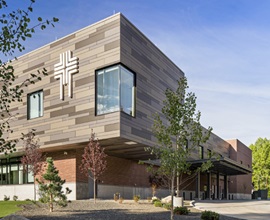For Complicated Care, One Family Favors McCall

Not long after moving to Valley County, Sandee and Wayne Dingman noticed that their young son wasn’t growing.
“You could visibly see the atrophy in his muscles,” Sandee said.
Sam, who was 5 at the time and who is now 10, underwent a series of blood tests ordered by Dr. Brandi Solace, a naturopathic doctor in McCall.
The tests revealed abnormalities with Sam’s liver and kidney functions and an elevated creatine kinase (CK) marker.
A normal level of CK for kids is 100 to 200 units per liter; Sam’s tests showed 6,000 to 10,000 units, indicating a muscular disease.
The Dingmans took Sam to see a specialist in Boise. The doctor recommended steroid treatment and to have Sam fitted with a wheelchair.
“He was rather fatalistic. We weren’t ready for that,” Sandee said. “We wanted a clear diagnosis and something more progressive and optimistic.”
Sam needed genetic testing, so Dr. Solace connected the Dingmans with the Muscular Dystrophy Association. Results showed Duchenne muscular dystrophy, a rare genetic disorder characterized by progressive muscle degeneration and weakness. There are medical treatments for this form of muscular dystrophy that may help slow its progression, but there is currently no cure.
While steroid therapy is a common treatment for muscular dystrophy, the Dingmans felt it was not a good option for Sam. They opted for a comprehensive bodywork approach to help reduce symptoms and improve the quality of Sam’s life.
This approach relies on a coordinated multidisciplinary team of care providers to treat the complicated issues of this disease.
Dr. Jon Currey of St. Luke’s Payette Lakes Family Medicine is Sam’s primary care provider, monitoring his health and ensuring coordination of care.
“Sam has some kind of therapy every day,” Sandee said. “If it wasn’t for family and the local providers, there’s no way we could manage Sam’s care.”
He goes to physical and occupational therapy at St. Luke’s McCall to build strength, maintain range of motion and motor function. During the school year, he receives therapy from the school district.
For muscle extensibility and joint contractures, Sam gets regular neuromuscular massage from Diana Hengerer, a medical massage therapist, and does daily stretching at home.
Chiropractor Dr. Deb Yaritz treats Sam to stay ahead of the risk for scoliosis. Therapy includes working on his legs and pelvic and spinal alignment with micro massage.
For pulmonary and lung function management, Sam has weekly swim therapy sessions with Sue Farrar at The Club.
Due to the complex nature of Duchenne muscular dystrophy, Sam makes an annual visit to Primary Children’s Hospital in Salt Lake City to see pediatric neurologist Dr. Russell Butterfield and a team of specialists, including a pulmonologist, a cardiologist, an endocrinologist and behavioral health and pediatric developmental specialists.
Duchenne patients and family members are at risk for depression and anxiety, and must learn to deal with the emotional realities of muscular dystrophy, so the Dingmans were surprised to find out behavioral health wasn’t included as they set up Sam’s care plan.
“How could it not be?” Sandee said.
Again, the community wrapped itself around the Dingman family, and Sam now receives counseling from Ashley Hughes of Central Idaho Counseling and medication management from Anne Marie Reed, a nurse practitioner in psychiatry. The Katie Beckett Program for children with developmental disabilities also provides support, including transportation to get Sam to his appointments.
“We wouldn’t be able to work full time without this service,” Sandee said.
There can be advantages to receiving care at a large medical center with increased access to specialists and research trials. But there are disadvantages, too, the Dingmans have concluded.
“In McCall, the care is personal and patient-centered. Everyone knows Sam,” Sandee said. “His team of care providers all work together. They’re progressive and support mental health care, complementary care and non-medical therapies.”
Sam loves the outdoors, skiing with his brother, Henry, traveling to new places, Tech Tuesdays at the library and Cub Scouts.
“For now, Sam can still do all the activities with his peers and hang with other 10-year-olds. He just lacks endurance,” Sandee said.
His favorite week of the year? The Muscular Dystrophy Association’s Summer Camp at Quaker Hill.
”He’s a very happy kid,” Sandee said. “He knows his diagnosis and knows the reality of it, but we all strive to find joy in each day.”
About The Author

Laura Crawford works in the Communications and Marketing department at St. Luke's.

